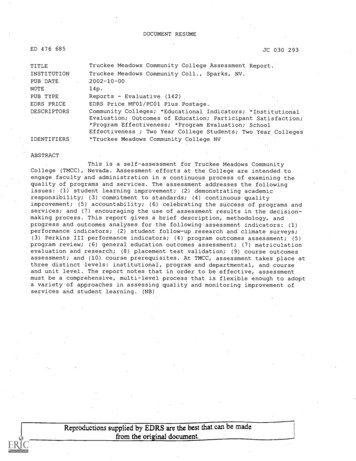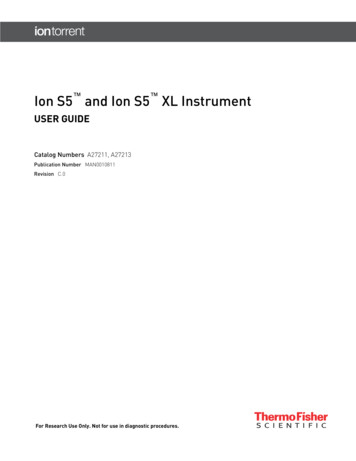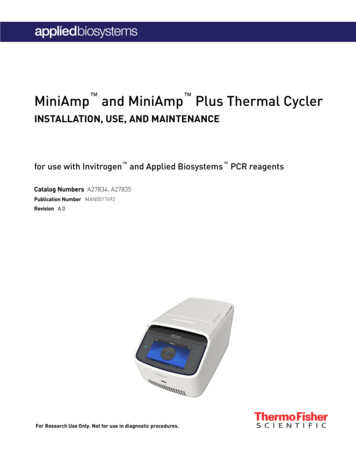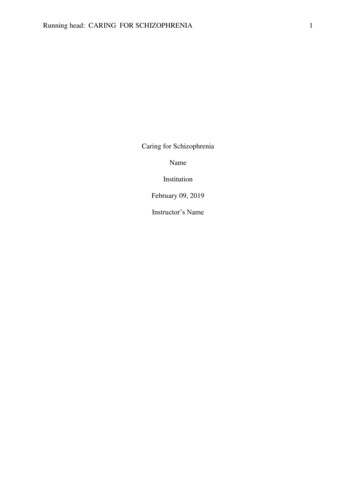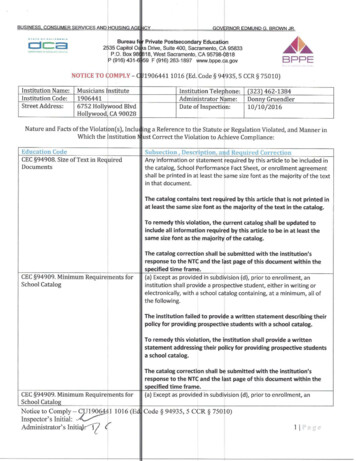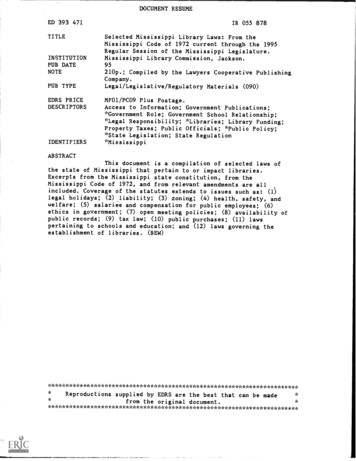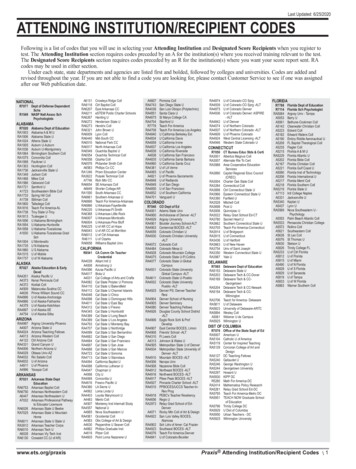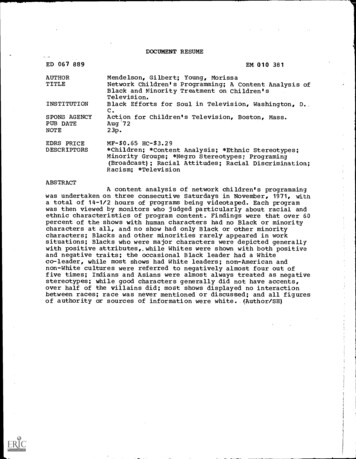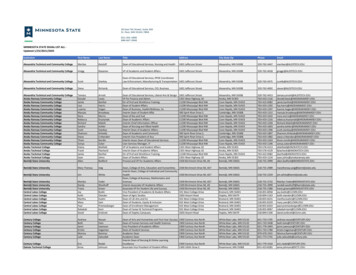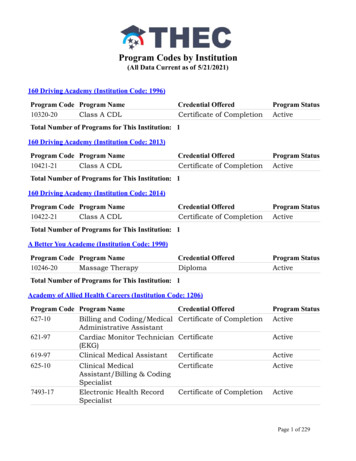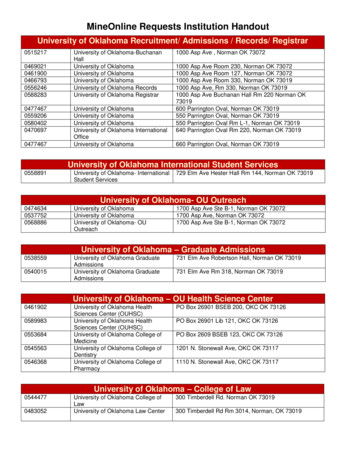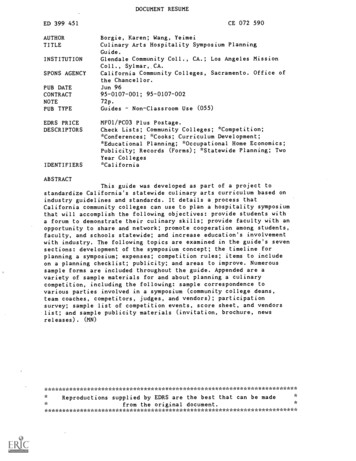
Transcription
DOCUMENT RESUMECE 072 590ED 399 451AUTHORTITLEBorgie, Karen; Wang, YeimeiCulinary Arts Hospitality Symposium PlanningGuide.INSTITUTIONSPONS AGENCYGlendale Community Coll., CA.; Los Angeles MissionColl., Sylmar, CA.California Community Colleges, Sacramento. Office ofthe Chancellor.PUB DATECONTRACTNOTEPUB TYPEJun 9695-0107-001; 95-0107-002EDRS PRICEDESCRIPTORSMF01/PC03 Plus Postage.Check Lists; Community Colleges; *Competition;*Conferences; *Cooks; Curriculum Development;*Educational Planning; *Occupational Home Economics;Publicity; Records (Forms); *Statewide Planning; TwoYear oom Use (055)ABSTRACTThis guide was developed as part of a project tostandardize California's statewide culinary arts curriculum based onindustry guidelines and standards. It details a process thatCalifornia community colleges can use to plan a hospitality symposiumthat will accomplish the following objectives: provide students witha forum to demonstrate their culinary skills; provide faculty with anopportunity to share and network; promote cooperation among students,faculty, and schools statewide; and increase education's involvementwith industry. The following topics are examined in the guide's sevensections: development of the symposium concept; the timeline forplanning a symposium; expenses; competition rules; items to includeon a planning checklist; publicity; and areas to improve. Numeroussample forms are included throughout the guide. Appended are avariety of sample materials for and about planning a culinarycompetition, including the following: sample correspondence tovarious parties involved in a symposium (community college deans,team coaches, competitors, judges, and vendors); participationsurvey; sample list of competition events, score sheet, and vendorslist; and sample publicity materials (invitation, brochure, newsreleases). *************************Reproductions supplied by EDRS are the best that can be madefrom the original ****************************AA
C-Etit g Sy,4.4b0sttgco0California Community Colleges(PERMISSION TO REPRODUCE ANDU.S. DEPARTMENT Of EDUCATIONOffice,of Educate:mai Research and improvernemDISSEMINATE THIS MATERIALHAS BEEN GRANTED BYED CATIONAL RESOURCES INFORMATIONCENTER IERIC1This document hes been rePrOduCed asreceived from the person or organizationoriginating 1.0 Minor changes have bean made to improvereproduction QualityPoints of view or opinions stated in INS docu-ment do not necesssrity represent officialOERI position or policyTO THE EDUCATION RESOURCESINFORMATION CENTER (ERIC)0Los Angeles Mission CollegeMien Caaalm,y CedersULM'S**, Ave. Sylmar. CA 91142.3245Abc*ozo IMBEST COPY AVAILABLE1500 N. Vezdago Ed. Glendale. CA II1201114101j
Contract/Agreement Numbers 95-0107-001 & 95-0107-002This document contains reports made pursuant to contract/agreement number 95-0107 for the development of aHospitality Symposium. This project was awarded to Los Angeles Mission College and Glendale Community Collegeby the California Community College Chancellor's Office. The projects are supported by the Carl D. Perkins VocationalEducation Act grant with Title DM, State Leadership, CHE funding sources.The Chancellor's Office of the California Community Colleges sponsored these grants, but the report does not necessarilyrepresent the views of the Chancellor, his employees or the state of California. The Chancellor, his employees,contractors and subcontractors make no warranty, expressed or implied and assume no liability for the information inthis report and will not knowingly infringe upon privately owned rights.Equal Opportunity PolicyThe Los Angeles Community College and Glendale Community Districts are committed to a philosophy of equalopportunity/equal access employment, educational programs and services. Thus, we are firmly committed to a policyof nondiscrimination on basis of race, color, national origin ancestry, religion, creed, sex, age, handicap, marital status,sexual orientation, veteran status in our employment or educational programs and activities.
CULINARY ARTSHOSPITALITY SYMPOSIUMPLANNING GUIDEKaren BorgieProject DirectorLos Angeles Mission. CollegeYeimei WangProject DirectorGlendale Community CollegeLos Angeles Mission College13356 Eldridge AvenueSylmar, CA 91342(818) 364-7600FAX (818) 364-7755Glendale Community College1500 North Verdugo RoadGlendale, CA 91208(818) 240-1000FAX (818) 547-1084June 1996
ForwardHome Economics Education Hospitality (HEEH) Occupations Profession Development grantswere awarded to both Glendale Community College and Los Angeles Mission College for theacademic years 1994-1996.During this time the two colleges have been working to standardize the statewide Culinary Artscurriculum based upon the American Culinary Federation Educational Institute (ACFEI)guidelines, the Council on Hotel, Restaurant and Institutional Education (CHRIE) and otherindustry standards.As the culmination of this two year project, the two colleges planned and hosted a state-wideHEEH Symposium for students in Culinary Arts programs throughout California. This eventwas held May 3, 1996 at Los Angeles Mission College. This Hospitality Symposium was to bepatterned after the Community College Fashion Symposium and provide a model that could bereplicated in the future.The following is a guide for planning a Hospitality Symposium. We have divided the planningprocess into segnients. We have attempted to provide the planner with a time line and concreteinformation that was utilized in the original symposium. We have also included suggestions forimprovement in areas that we thought needed changing. We have included samples ofcorrespondence, charts, and other written materials in the Appendix. It is our hope that theconcepts that were developed for the initial symposium will be expanded as the concept ofHospitality changes. We also hope that those involved in the next Symposia will find it asrewarding and challenging as we did.Karen BorgieLos Angeles Mission CollegeYeimei WangGlendale Community College
Table of ContentsI. Symposium Concept DevelopmentH. Time Line for PlanningHI. ExpensesIV. Competition RulesV. PublicityVI. Checklist for PlanningVII. Areas to ImproveAppendix13910262728
I. Symposium Concept DevelopmentThe Hospitality Symposium was a "first-time" event for the State Community College System.The goal of this event was to provide students in Culinary Arts/Hospitality programs throughoutthe state with an opportunity to demonstrate their talents in a variety of competitions. The Chefde Cuisine Association of California, the local chapter of the American Culinary Federation(ACF) agreed to sponsor the event. For some students, this was their first involvement with aprofessional organization like the ACF. All community colleges with Hospitality Programs inCalifornia were invited to participate.Objectives of the symposium were:To provide students with a forum in which they could demonstrate their skills.To provide faculty with an opportunity to share and network.To promote cooperation among students, faculty and schools statewide.To increase the involvement of education with industry.This event brought students together from a variety of programs, but who had similar careergoals. In the competition arena students were able to demonstrate their skills and at the sametime learn from one another. Faculty had an opportunity to network and share in an informalatmosphere. Bringing students and faculty together from different schools helped to promote"a spirit of cooperation." Since many Culinary Arts/Hospitality programs are small, asymposium can enhance California programs by providing an arena for demonstrating skills andsharing ideas and successful teaching strategies that can be effectively utilized statewide toimprove all Culinary Arts programs.In order to provide greater opportunities for competition, both cooking and non-cooking eventswere planned. Since the American Culinary Federation is the professional leader in CulinaryArts, its sponsorship for the hot and cold food competitions should be obtained if possible. Thecompetition rules and judging standards are established, widely available, and considered to bethe "industry gold standard." As part of the ACF's commitment to education, the ACF chaptersthroughout the state will interface with the area community college teams to help prepare themfor competition. This joint effort increases the involvement of industry professionals with theeducation community. Students are exposed to industry standards and expectations and have anopportunity to begin networking with industry representatives as well as fellow students.Since the field of hospitality is multifaceted, competitions featuring the other aspects of theindustry should be included. Ideas ranging from travel posters/displays to centerpiece flowerarranging to restaurant design could be developed. The non-cooking events that were includedin this symposium were based upon the results of a survey sent to all California CommunityColleges with Culinary Arts programs. The non-cooking competitions that were included in the17
Symposium were Garde Manger, Dining Room and Menu Presentation, and a Knowledge BowlCompetition.Possibilities for competition events are many and varied and the format a symposium can beadapted to meet the needs of the events planned.82
II. Symposium Time LineDate for the EventEarly May was the time of year that was selected for the Symposium. Since the grants wereawarded for an academic year, a fall or early winter date would be very difficult. In addition,many observed holidays, e.g. Thanksgiving, are very close to the end of the fall semester.Also many programs may have new faculty and students in their programs who might not beready for competition after only one semester or less.Industry participation is essential for the success of this event. Many company representativeshave additional pressures during Thanksgiving /Christmas /New Years Holidays and may be lesswilling to donate products and services during those times.Spring provides a longer training time for students and faculty, however, there is no setstatewide time for Spring break. Most breaks are planned for March or April and teachers arevery difficult to contact during break times. The need to communicate with faculty increasesas the time of the competition nears. When the early May date was set for this symposium, itwas hoped that it would come before the"graduation rush."Six to Nine Months Before the CompetitionIt is important to select an event logo to use on stationery and all printed materials. Since thisevent was planned jointly by two schools, funded by a grant from the Chancellor's Office, andsponsored by the ACF, a logo that included all groups was necessary. The logo and stationerywere designed and used for all correspondence, printed materials and awards. We wouldencourage the continued use of the same logo. An engraving of the first symposium logo is onfile and available from Dave's Trophies at (818) 579-5637.As soon as a date was set, a preliminary letter with a survey was sent to all community collegeswith Culinary Arts programs. A major problem is to whom this letter should be addressed. Thefirst letter announcing the competition and date were sent to Vice-Presidents, Deans ofVocational Education and Culinary Department Heads. It would be wise to include a surveyform that describes a variety of competitions with a place for the respondents interests andsuggestions. In addition to the survey, consider including as many competition guidelines aspossible. A copy of the ACF Approved Culinary Competitions & Expositions was sent to eachschool with the initial mailing. A date for return of the survey should be included. A sampleof each is provided in the appendix.The competition field and the events that showed the highest interest level should be determined.In this Symposium twelve schools indicated an interest in competing in at least one event, someschools entered all events. When there is limited interest, look for ways to combine events toincrease participation. Dining Room Table Top and Menu Development were combined into acompetition that had more substance than either by itself.Begin the application process for ACF sponsorship during this time. If a faculty member is anACF member, he/she should approach a local chapter board member. If there is no ACF faculty
member, the faculty coach can approach a board member directly. Because of the strong ACFcommitment to education, the local chapter is usually very helpful. The chapter in whose regionthe event is being held is the chapter that will sponsor it. ACF sponsorship provides manybenefits. It assures that the level of competition will meet industry standards. It also provideswell-defined competition rules and the judges must be selected from the official ACF JudgeCertification list that is provided by the sponsoring chapter. In addition to assuring professionalstandards,the local chapter provides a certificate of insurance for the entire event. This is veryimportant to the college administration and others who may be providing equipment for theevent. There is a 75.00 application fee that must be paid by the host school.When schools indicated an interest in competing in the ACF events, a letter was sent to theschool, providing each with the name of the local ACF chapter president. A letter was then sentto that ACF chapter informing them of the competition and the school's intent to participate.Contact of the ACF chapter was left to the faculty member. Samples of these letters areincluded in the appendix.In January a workshop was planned to provide a mock demonstration of an ACF hot and coldfood competition. This workshop was offered by Rudy Garcia C.C.E.,A.A.C., President ofChef de Cuisine Association of California. It was developed as an Instructional ImprovementActivity by the Los Angeles Mission College Flex Coordinator. Instructional ImprovementActivities must be approved for credit by the Flex Coordinator on an individual campus basis.The LAMC coordinator included information about this workshop with a list of other FlexActivities that was sent throughout the state community college system in December, 1995.Information about this workshop was also included with the letters that were sent to the schoolswhich indicated an interest in the ACF events. This workshop was canceled due to lack ofparticipants, but with publicity earlier in the school year interest might have been better. Aworkshop or meeting of this type would be very helpful because it could answer the questionsthat many coaches had. Coaches who were not familiar with the ACF rules of competition oftenfound the ACF booklet difficult to follow.If new competition events are being planned, begin working to develop the competition rules.It is important to obtain any industry standards that are available. Advisory CommitteeMembers, professional organizations, and industry resources may be helpful. As the competitionguidelines are developed, ask for ideas from other professionals. Critiques are important todetermine if the rules are clearly written. The development of the scoring instrument at thesame time helps to focus on the objectives of the event.In late January Culinary Arts instructors who had not returned the survey form were called.This was a non-productive activity. It was very difficult to contact the faculty member in chargeof the Culinary Arts program because many of them were adjunct faculty and have limited timeand often did not have a readily available phone number.Three to Five Months Before the CompetitionSend out competition rules, entry forms and any other pertinent information about the upcomingevent. It is important to maintain a high visibility through letters and phone calls so that facultymembers do not forget about the competition, especially when they are scheduling catering410
events and other functions.Begin planning publicity and the solicitation of products for the event. However, it is still tooearly to begin any major solicitation efforts.Meet with the college financial staff and discuss with them the financial processes and constraintsof the institution. It is also important to meet with the facility staff to determine potentialproblem areas. Develop a facility plan so that staff can have some understanding of thecompetition requirements. Many people have difficulty visualizing the various competitions.Do not take anything for granted, e.g. for this symposium we were surprised to learn that dueto ventilation requirements, the hot food competitions could not be held indoors.One to Two Months before the CompetitionBegin to ask individuals to be judges for various competitions. The judges for the ACF eventsmust be listed on the ACF application, so they must be asked at the time application is made forACF sponsorship. These judges must come from the list of ACF approved judges. The judgesfor the non-ACF events should work in the area in which they will be judging, e.g. a catereror restaurant manager judged the Dining Room Table Top/Menu Design competition, anexecutive chef judged the Garde Manger competition.The solicitation of scholarships, products for the competition and door prizes should begin atthis time. Develop a list of possible donors, contact people, addresses, etc. Begin with a phonecall and follow up with a letter. The order can be reversed, but letters are easily lost and asecond one may need to be sent. Careful record keeping is import so that recognition can begiven to the correct people. The best response for donations was from industry representativesthat we knew personally. A general letter to industry with which we included a response cardgenerated very little response. Vendors who support the sponsoring ACF chapter tend to begenerous. Do not be afraid to ask for what is needed, e.g we called Pepsico and asked for sevenhundred cans of soda for the competitors and guests. Pepsico kindly donated seven hundred canswithout hesitation. All of the food for the Hot Food Event and half of the produce for the GardeManger competition was donated.Responses should be received from the various teams during this time. Develop a competitionform that shows the competition field for each event. This provides the information needed forscheduling the various events. Send the competition field form to the schools who are planningto compete. Seeing who the competitors are helps to increase the interest and enthusiasm forthe competition.Determine the prizes, medals or trophies, for the events. ACF events must use ACF medals( 15/medal and 5/diploma). An engraving was made of the Symposium logo to use for allplaques and medals. This engraving can continue to be used indefinitely. Plaques were givento the judges and medals were awarded to the first through third place winners for each event.In addition all first place winners received a coupon for a free video tape from the CulinaryInstitute of America, Greystone. The hot food team with the highest point score received a setof knives from Messermeister Knives. Student competitors were very appreciative of these fineprizes. Therefore, it may a better use of time to concentrate on obtaining these fine prizes for5I1
the competitors rather than door prizes for the spectators.ICBegin to make a list of the equipment, supplies, and any other needs of each event. Try to doas much work ahead as possible. Drawing a facility plan helps with the planning for other eventneeds.Publicity begins to become more important at this time. Develop flyers for the competition andsend to invited guests, with product solicitation letters, and to have available to give out forposting whenever there is an opportunity.If hotel accommodations are needed by either
TITLE Culinary Arts Hospitality Symposium Planning. Guide. INSTITUTION Glendale Community Coll., CA.; Los Angeles Mission. Coll., Sylmar, CA. SPONS AGENCY California Community Colleges, Sacramento. Office of. the Chancellor. PUB DATE Jun 96 CONTRACT 95-0107-001; 95-0107-002 NOTE 72p. PUB TYP
